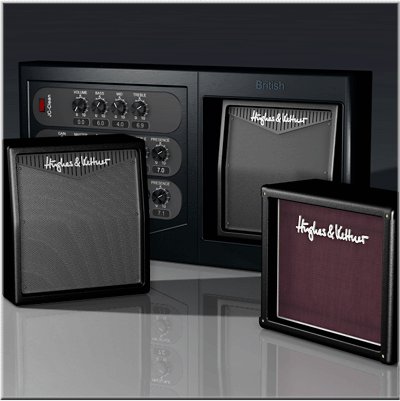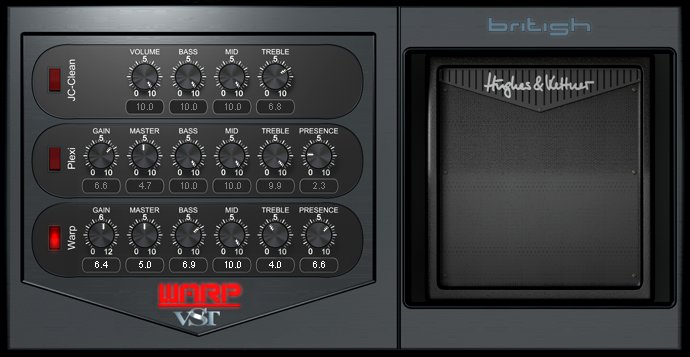VST Warp

 As a guitarist, rather interested in the big sound of big amps with big tubes, the idea of connecting my guitars into a plug-in would rather make me derisive, in total subjectivity, without even trying. My JEM into a plug-in, arf arf arf ! Well FeedBack, stop giggling and think about those who don't have any amp, to those who don't have understanding neighbours, to those who want to play with headphones at night, etc.
As a guitarist, rather interested in the big sound of big amps with big tubes, the idea of connecting my guitars into a plug-in would rather make me derisive, in total subjectivity, without even trying. My JEM into a plug-in, arf arf arf ! Well FeedBack, stop giggling and think about those who don't have any amp, to those who don't have understanding neighbours, to those who want to play with headphones at night, etc.
As only bad guitarists don't change their mind (this suits me better !), I've decided, however, to test one of those software amp modelers.
In association with Hughes & Kettner (ah yes, even so), Steinberg then offer us Warp VST, which pretends to emulate 3 types of famous amps by itself : Jazz Chorus, Plexi and Rectified. I'll let you put a brand on each of these models. You can find in this plug-in the 3 typical sounds of electric guitar : clean, crunch and distorted.
The principle is simple : you choose one of the three amps, you plug one of the 3 available cabinets (4 x 12 British, 4 x 12 Greenback or Combo), you play with the buttons and it should sound good. I tried the possible combinations in two ways : playing the guitar through it, and trying all the parameters in the demo songs released with the CD.

First amazing thing : the background noise. Warp reacts like an amp, and as a consequence it doesn't just amplify the sound, but also the interfering noises, and not a little. You have to be vigilant then, and kill any source of incongruous background noise such as your computer screen ! A Noise Gate as an insert will be more than welcomed in this case. I noticed the same thing with AmpliTube and Revalver?
The Jazz Chorus section is dedicated to clean sounds. The adjustments are rather minimal : volume, bass, mid and treble. The action of the three last ones is subtle, not to say limited, the variations between extreme settingss are not so evident. On the other hand, the choice of the cabinet will be rather interesting. The combo model gives a good presence while the two 4 x 12 give more bass and amplitude.
In short, Warp delivers a clean sound which is completely usable and will give really something additional to those who are used to plugging their guitar directly into the mixboard or the soundcard. By setting the volume to maximum, you will be able to distort the sound slightly in a fairly pleasant way.
Warp consumes only small CPU ressources, an important point that should be emphasized.
Now let's get to the sounds called crunchy. Houla la, I talked too fast, the performance bar makes a jump of 15% ! And therefore, the software adds its own latency to the soundcard's one, so be careful.
In this option, we have more settingss : gain, master, bass, mid, treble and presence. No need to shell the function of each one, isn't it ? As for the Jazz Chorus, the equalizers aren't very violent, you'd rather like the basic sound because it will be difficult to obtain something else.
To my fancy, the Plexi section is the most interesting of the plug-in. Of course, there's no way to retrieve exactly the sound you would obtain with a well-heated tube amp and a good mike in front of it, but it is quite easy to obtain a mellow, sweet sound, which distorts only when you attack the string harder. Maybe the guitar track played back separately wouldn't make the illusion on an experienced guitarist, but once it is mixed, it fits without any problem.
Little advice : try the Plexi with the gain half-opened and the middle pickup of a Strato, I'm sure you'll like it. With a neck humbucker, it's not too bad either ! The only imperative will be mastering the background sound which is still, however, fairly noticeable.
Here we are promised a big sound ! Surprise, the Warp part seems to be less fond of ressources than the Plexi, we gain a little bit of latency back.
The settings are the same as for the Plexi but prove to be more efficient and more sensitive. You can really work the sound out.
But, God, the background noise... As soon as you set the gain more than halfway up, the noise you get can't be ignored or hidden anymore. I know that when I record an amp with a mike in front of it, I record the amp noise too and the one generated by the mike, but I've never had a similar background noise. No Noise Gate will be able to get through this, you will loose in this case the attack and the sustain. All the more so as in order to have a maximum distortion, you have to attack the plug-in with a high gain. On this subject, two VU-Meters (input and output) should have been welcome, because you don't really know where the sound level is.
Even by playing with all parameters, I was not successful in having a lead sound worthy of the name : the whole remains flatty, linear and to tell you all about it, transistor. The manual promises that you will be able to play like Steve Vai, well, it is not even true !
So what, all not good ? No no, the Warp part is very good for one thing : big rythms in "E"chords with a very fat sound ! As for the Plexi, once in the mix, it makes illusion, best : it sounds... And it sounds even very big. To my humble opinion, this Warp part should be reserved certainly to this use.
So, as a consequence : when you record a guitar track, it's the unprocessed sound which is memorized by the sequencer, and on this point, Warp has one advantage that no amp will ever offer you : to be able to modify the sound after recording. Yes, you apply Warp to a dry guitar track, it is therefore quite possible to change from the Plexi to the Warp, afterwards, if you want. One can admit that it is fairly cumfortable to be able to rectify the gain and the EQ after recording.
You could reproach Warp the fact that it does not offer any internal effect like Revalver and Amplitube do, for example. My answer will be : considering the number of plug-ins available for your favourite sequencer, comercial or freeware, I don't see where the problem is... Warp pretends replacing an amp, and nothing else.
Effectively, I sneer a little less. Without committing myself to what I've said about very distorted or lead sounds, Warp appears to be quite usable. I imagine the following conditions of use :
-
The musician whose main instrument is not the guitar but who plays sometimes a few tracks. This one wouldn't buy an amp or a dedicated multi-effect unit.
-
The musician whose neighbours are touchy about the sound level getting outside his house.
-
The musician who wants to work at night with headphones on, without arousing the whole household.
-
The musician who is definitively angry with his guitarist-friend. It can happen ! Or the one who wants to keep all the fans to himself !
-
The guitarist who wants to have at his disposal other sounds than the ones offered by his usual set and who will enjoy putting a 4 x 12 on a Jazz Chorus.
- Etc.
The more demanding guitarists (they are usually untreatable concerning their sound) would certainly rather like to use their own gear.
As stated above, it must be noticed that Warp adds its own latency to the soundcard's one. As a consequence, for a real-time use, it is essential to have a good driver which will offer less than 5-ms latency...
I've prepared you a mix of two of the MP3 demo released with the software. There isn't any faking, I could check it because the original songs are released, too... The song begins with the Jazz Chorus, goes on with the Plexi, then finishes with the Warp. While I'm here, I think Virtual Guitarist assumes the acoustic rythm guitars. To download the demo, click here (1765 KB).
As a conclusion I'll say that Warp offers three things : a rather nice crunch sound, a usable clean sound and a distorted sound of which use will be rather limited, to my opinion, all packed in a very-easy-to-use interface, for a price of 359 ? (VAT included).
Pros
- The reasonable CPU load
- The simplicity of the interface
- The Plexi sound
Cons
- The heavy background noise beyond a certain level of distortion
- The extreme distortions, neither usable nor credible
Required set up :
- PC : Intel Pentium III or AMD K7 500 MHz processor - 256 Mb of RAM - Windows 98/ ME/2000/XP
- MAC : G4 up to 400 MHz processor - 256 Mb of RAM - MacOS 9x
Pascal VALENTIN, on the 01-10-2002
 Page viewed 15316 times
Page viewed 15316 times




